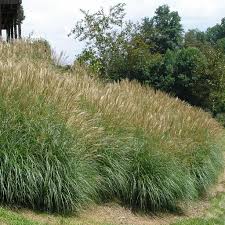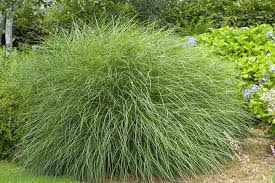Miscanthus Adagio, also known as Miscanthus sinensis ‘Adagio’, is a really nice plant that people like to put in their gardens. It’s a type of grass that looks pretty and can grow in many different places.
This grass has leaves that are thin and kind of bendy. They can be green or sometimes a little bit silver. The leaves make a big bunch that looks nice all year round. But what’s even cooler is that in late summer, this grass grows these fluffy things that are pinkish at first, and then they turn white. These fluffy things look like feathers and they stick up above the leaves. Birds like to visit these fluffy things, and they also attract helpful insects to the garden.
The best thing about Miscanthus Adagio is that it can grow in different places. It’s okay with the sun shining on it, or if there’s a little bit of shade. It can also live in different kinds of soil, like the kind that’s heavy and sticky, or the kind that’s sandy. Once you plant it and let it grow for a bit, you don’t really need to do much to take care of it. So, whether you’re really good at gardening or you’re just starting, this grass is a good choice.
Gardeners and people who make yards look nice like to use Miscanthus Adagio in many ways. Some people put it by itself so everyone can see it. Others like to put a lot of these grasses together in a line, or all spread out in a big area. You can even put this grass in a big pot if you want. When you see a bunch of them together, it looks really pretty when the wind makes their leaves move.
When it gets really cold in the winter, this grass needs a blanket of something like leaves or straw to keep its roots warm. And when spring comes back, you can trim off the old stuff to help it grow new leaves. This helps it look neat and tidy.
In short, Miscanthus Adagio (Miscanthus sinensis ‘Adagio’) is a nice kind of grass that people like to put in their gardens. It has pretty leaves and fluffy things that grow on top of them. It’s not picky about where it lives, and you don’t have to do too much to make it happy. People use it in lots of different ways to make their gardens look even better. Just remember to give it a cozy cover in the winter and a little haircut in the spring, and it’ll keep making your garden look great.
Read Also: Fertilizer Application, Pests and Diseases Control in Cocoa
Growing and Care Guide of Miscanthus Adagio

Miscanthus Adagio, also known as Miscanthus sinensis ‘Adagio’, is a beautiful and easy-to-care-for ornamental grass that can add charm and elegance to your garden or landscape. Here’s a simple guide to help you grow and take care of this lovely plant:
1. Location and Sunlight: Choose a spot in your garden that receives full sun to partial shade. Miscanthus Adagio can tolerate different light conditions, but it usually grows best with at least 4-6 hours of sunlight per day.
2. Soil Requirements: This grass is quite adaptable when it comes to soil types. It can grow well in a variety of soils, including clay, loam, and sandy soils. Make sure the soil has good drainage to prevent waterlogging.
3. Planting: Plant Miscanthus Adagio in spring or early fall. Dig a hole that’s slightly larger than the root ball of the plant. Place the plant in the hole, making sure the top of the root ball is level with the soil surface. Fill the hole with soil, and gently tamp it down around the plant. Water thoroughly after planting.
4. Watering: While Miscanthus Adagio is drought-tolerant once established, it’s important to water it regularly during the first growing season to help it establish strong roots. After that, you can rely on natural rainfall, but make sure the plant doesn’t completely dry out during prolonged dry periods.
5. Mulching: Applying a layer of mulch around the base of the plant helps retain moisture, suppress weeds, and protect the roots from temperature extremes. Mulch with a layer of organic material, like straw or wood chips, to a depth of 2-3 inches.
6. Pruning: In late winter or early spring, before new growth starts, trim back the previous year’s foliage to about 4-6 inches above the ground. This helps maintain the plant’s neat appearance and encourages fresh growth.
7. Fertilizing: Miscanthus Adagio doesn’t require heavy fertilization. You can apply a balanced, slow-release fertilizer in early spring, but be careful not to over-fertilize, as this can lead to excessive leaf growth and weak stems.
8. Overwintering: In colder climates, the grass can benefit from a protective layer of mulch or straw over its base during the winter. This helps insulate the roots from freezing temperatures.
9. Dividing: Every 3-4 years, consider dividing the plant in early spring to keep it healthy and prevent overcrowding. Dig up the plant and carefully separate the clumps into smaller sections, each with its own set of roots. Replant the divisions at the same depth they were originally planted.
10. Pests and Diseases: Miscanthus Adagio is generally resistant to pests and diseases. However, keep an eye out for common garden pests like aphids or grasshoppers. If you notice any issues, treat them promptly using appropriate methods.
By following these simple steps, you can enjoy the beauty and grace of Miscanthus Adagio in your garden while providing it with the care it needs to thrive and flourish throughout the seasons.
Read Also: Categorization, Damages Caused, Diagnosis and Control Methods of Plant Diseases
Miscanthus Sinensis Gracillimus

Miscanthus Sinensis Gracillimus, often referred to simply as Gracillimus, is a stunning ornamental grass that adds a touch of elegance and beauty to gardens and landscapes. This graceful grass is known for its slender and refined appearance, making it a favorite among gardeners looking to create a sophisticated and serene outdoor space.
With its scientific name of Miscanthus sinensis ‘Gracillimus’, this grass stands out due to its gracefully arching leaves that sway gently in the breeze. The foliage is narrow and fine-textured, creating a soft and delicate visual effect. The leaves of Gracillimus are typically green, but they can take on a lovely silvery hue, especially when they catch the sunlight.
One of the standout features of Miscanthus Sinensis Gracillimus is its feathery plumes that emerge in late summer and persist well into the fall. These plumes start as delicate pinkish tassels and gradually transition to a creamy white color as they mature. These ornamental plumes add a sense of movement and life to the garden, making it a popular choice for those seeking to create a dynamic and captivating landscape.
Gracillimus is versatile when it comes to where it can grow. It thrives in full sun to partial shade, making it adaptable to various lighting conditions. The grass also has a tolerance for different soil types, including clay and sandy soils, which makes it a versatile option for a wide range of garden settings.
Maintaining Miscanthus Sinensis Gracillimus is relatively straightforward. Once established, it requires minimal maintenance. In late winter or early spring, you can trim back the previous year’s growth to encourage new growth and maintain its tidy appearance. Additionally, providing a layer of mulch around the base of the plant can help retain moisture, suppress weeds, and protect the roots from extreme temperatures.
Gardeners and landscapers often use Miscanthus Sinensis Gracillimus in various ways to enhance outdoor spaces. It can be planted as a specimen plant to draw attention, or it can be used in groupings to create a soft and lush backdrop for other plants. Its graceful form and delicate plumes also make it a popular choice for borders, pathways, and even container plantings.
In conclusion, Miscanthus Sinensis Gracillimus (Miscanthus sinensis ‘Gracillimus’) is a remarkable ornamental grass that adds a touch of refinement and charm to gardens and landscapes. Its slender leaves, graceful arching form, and striking plumes make it a standout choice for those looking to create a visually captivating outdoor space.
Whether used as a focal point or as part of a larger planting scheme, Gracillimus is sure to elevate the aesthetic appeal of any garden and provide a sense of tranquility and beauty.
Read Also: How to Educate Yourself on Climate Change
